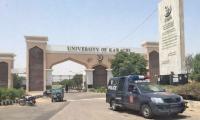An initial look at the roughly 175-year-old Kharadar police post leaves one in awe of its past grandeur. This 1860s ‘police chowki’ was once an important part of the colonial administration to maintain law and order among the locals in Bunder Quarter, in Karachi’s ‘black town’ area.
The chowki, though small, wielded a significant presence. It was located at a commanding position to fully view the historic Kharadar Chowk from which eight streets radiated, providing access to the inner core of historic Karachi.
At the rear was a vast open ground, one of the few Muslim graveyards in the city. Only a small mosque was situated on the north east of the chowki, and was positioned so that police officers stationed in the building could have an unrestricted view of the entire surrounding area.
The chowki building – elegant in its construction – had in the past decades fallen on bad times. Its use was comparatively limited and many additions were made by blocking the openings with masonry, laying an extra concrete floor on the original stone floors and applying plaster on stone masonry walls. The pitched roof was built with well-crafted wooden trusses and wooden joists, finished internally with wooden planks. Many of the planks had been damaged due to rainwater ingress. Externally, lovely terracotta roof tiles with the manufacturing mark of 1865 covered the entire roof.
While small in scale, the building has an imposing presence because of its architectural character. The accommodation consists of one room, 20’x12’ in size with a pitched roof 19’ high, fronted by a 6’ wide and 10’ high veranda with a flat roof. However, it is the massing of the structure with its high-pitched roof and an arcaded veranda that endows it with a special character.
When restoration work started, and the blocked openings were opened in the veranda, three openings in the front and one each on two sides revealed the simply built shoulder-flat-arch which gave an arched character as if an arcade. The removal of the entire internal and external cement plaster which was a later addition, exposed the original coarsed dressed stone internally and externally. Similarly, the removal of cement concrete flooring exposed the stone flags, although damaged because of indentation caused at the time of laying the new floor.
The rescue of this important building is beholden to the efforts of Karachi’s South Zone Police. The department was able to get the restoration work done through their efforts to collect resources.
Now the police chowki has once again resumed its commanding position; entered via a paved court and bordered by Kharadar Bagh with 200 trees and a small garden pavilion, which is the only open green, cool space for the community particularly women and children of the area.
As a gesture to the community, the building has been gifted to the community as the Kharadar Police Chowki Library. The library is frequented by children who find some respite from the dense and highly polluted environment they are surrounded by. This library is the first step towards improving police-community relations in the vicinity. Imagine a restored police chowki turned into a library for children of the area. One must also acknowledge the support rendered by the district administration of the area (South) in helping the police establish this library.
Protecting heritage in Karachi is an arduous task and protecting police heritage buildings is an even bigger challenge. Restoration of heritage comes as peripheral to police work. Coupled with this, the department does not have architects and masons skilled in this work. Which is why support from Ms Yasmin Lari was needed – and she rose to the occasion.
Ms Lari and her team took this as an extension of the Rahguzar Walking Street area in Karachi’s old town which starts from Denso Hall and now with the restoration of this chowki culminates on Kharadar Chowk.
Along the way, one steps back into time while passing through the ‘old quarters’, home to the once majestic buildings and pavements that were seriously threatened had Ms Lari and her team, supported by the South administration, not come stepped up to preserve and restore it.
The Sindh Police boasts several historic buildings, both in Karachi and in the hinterland. The department under its present leadership and generously supported by the government of Sindh has embarked upon cataloging them and then restoring them gradually.
The Sindh Police is the oldest force in the subcontinent and was the first force which was raised in 1843. In order to live up to its glorious history and architectural grandeur, the department must protect and preserve its heritage, its legacy and its traditions.
The writer is currently serving as
the deputy inspector general of police in Sindh.
FAO recognises home gardening as crucial strategy to enhance household food security and nutrition, particularly in...
Pakistan’s judicial system has evolved in a complex manner since country’s inception
Understanding between PML-N and PPP to unite despite their differences is one bright spot
Mushroom growth of housing societies has claimed tens of thousands of acres or possibly millions of acres over decade
These slogans often become symbolic rather than transformative, serving as reminders of unfulfilled promises
Tulsi Gabbard, incoming DNI is seasoned military leader who completed Officer Candidate School at Alabama Military...







